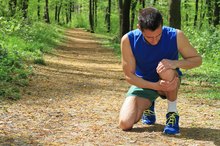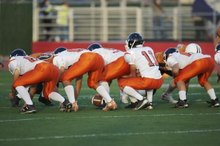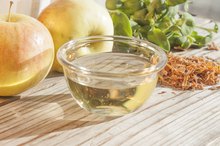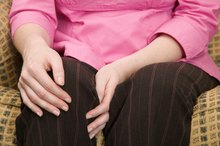What Causes Fluid on Your Knee?
Fluid on the knee is known as a knee effusion 3. Joints naturally contain some fluid to help lubricate and cushion the joint while you move. However, certain conditions can lead to an excess buildup of fluid. When this happens, the knee can swell and become painful and stiff. See your doctor for an accurate diagnosis if you notice these symptoms 2. Your doctor may order x-rays or blood tests or remove some of the fluid to determine the cause of your effusion.
If you are experiencing serious medical symptoms, seek emergency treatment immediately.
Acute Injuries
Whenever the body is injured, inflammation occurs in the area of the injury. Inflammation accompanying acute injuries to the knee often cause excessive fluid buildup within the knee joint. These injuries may include broken bones, meniscus tears or tears of the ligaments, tendons or muscles that support the knee. A dislocated kneecap can also cause a knee effusion. Rest, nonsteroidal anti-inflammatory medications such as ibuprofen (Motrin, Advil) or naproxen (Aleve) and bracing may be used to help treat knee injuries. Surgery may also be required, depending on the type of injury.
- Whenever the body is injured, inflammation occurs in the area of the injury.
- These injuries may include broken bones, meniscus tears or tears of the ligaments, tendons or muscles that support the knee.
Overuse
A Fluid-Filled Sac on the Front of the Knee
Learn More
Overusing the knee, such as by training or exercising too hard, too fast or beyond personal limits, may cause excessive fluid to accumulate in the knee. This accumulation occurs because of inflammation. Overuse may lead to inflammation of tendons -- called tendonitis -- or balloon-like bursal sacs -- known as bursitis -- around the knee. Overuse may also cause sprains or strains of muscles or ligaments in or around the knee, producing inflammation and an effusion. Rest and nonsteroidal anti-inflammatory medications may be used to treat effusions due to overuse.
- Overusing the knee, such as by training or exercising too hard, too fast or beyond personal limits, may cause excessive fluid to accumulate in the knee.
- Overuse may also cause sprains or strains of muscles or ligaments in or around the knee, producing inflammation and an effusion.
Arthritis
In arthritis, inflammation occurs deep within the knee, leading to an effusion. The two most common forms of arthritis -- osteoarthritis and rheumatoid arthritis -- frequently affect the knees 1. In osteoarthritis, the joint is gradually destroyed over time by repeated knee movements. In rheumatoid arthritis, the immune system attacks the synovial lining that surrounds the inside of the joint. Fluid buildup, pain, stiffness and joint deformity can occur with both types of arthritis. Less commonly, arthritis in the knee is caused by an abnormal accumulation of uric acid crystals in the joint, called gout. X-rays, magnetic resonance imaging (MRI) scans and blood tests can help determine whether arthritis is the cause of fluid on the knee and which type of arthritis is present.
Infection
How to Tell if You Have a Bruised MCL
Learn More
Infection in the knee joint can also lead to fluid buildup. The knee may become infected when an injury produces an opening near or in the joint, allowing germs to travel directly into the knee. Other infections occur when germs enter the knee from the bloodstream. Infections in the knee are usually caused by bacteria, although fungi and viruses may sometimes be the culprit. An infected joint is often warm and red. Other symptoms outside the knee may be present as well, such as a fever, chills, nausea or stomach cramps. Blood tests and examining a small sample of fluid will help determine whether an infection is present and the exact type of germ. Treatment generally includes antibiotics and possibly draining the infected fluid from the knee.
Reviewed by: Mary D. Daley, M.D.
- Infection in the knee joint can also lead to fluid buildup.
- Treatment generally includes antibiotics and possibly draining the infected fluid from the knee.
Related Articles
References
- Caspian Journal of Internal Medicine: Knee Osteoarthritis Prevalence, Risk Factors, Pathogenesis and Features -- Part 1
- American Family Physician: Evaluation of Patients Presenting with Knee Pain -- Part I. History, Physical Examination, Radiographs, and Laboratory Tests
- American Academy of Orthopaedic Surgeons. Arthritis of the knee. Updated June, 2014.
- Centers for Disease Control and Prevention. Arthritis: Risk factors. Updated March 7, 2019.
- Gersing AS, Link TM. Imaging of osteoarthritis in geriatric patients. Curr Radiol Rep. 2016;4(1):4. doi:10.1007/s40134-015-0133-9
- Arthritis Foundation. Lab tests for knee diagnosis.
- American Academy of Orthopaedic Surgeons. Knee arthroscopy. Updated September, 2016.
- American Academy of Orthopaedic Surgeons. Osteotomy of the knee. Updated June 2017.
- American Academy of Orthopaedic Surgeons. Total knee replacement. Updated August, 2015.
- Arthritis Foundation. Diagnosing knee arthritis and other problems.
Writer Bio
I hold a Master's degree in exercise physiology/health promotion. I am a certified fitness specialist through the American College of Spots Medicine and an IYT certified yoga teacher. I have over 25 years experience teaching classes to both general public and those with chronic illness. The above allows me to write directly to the reader based on personal experiences.






